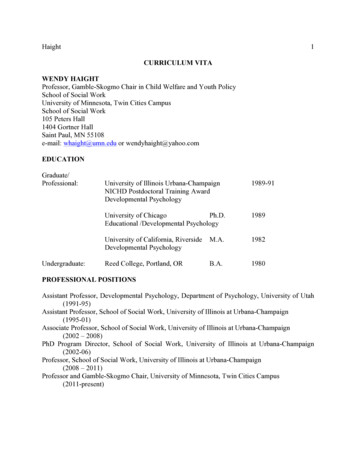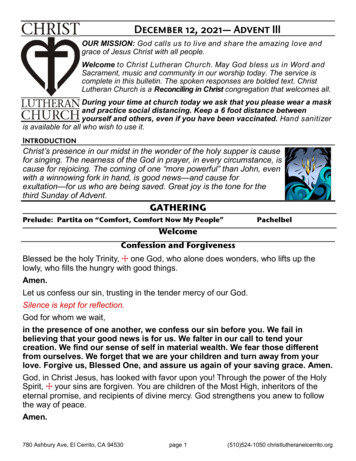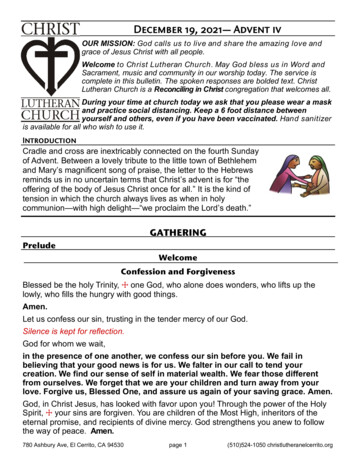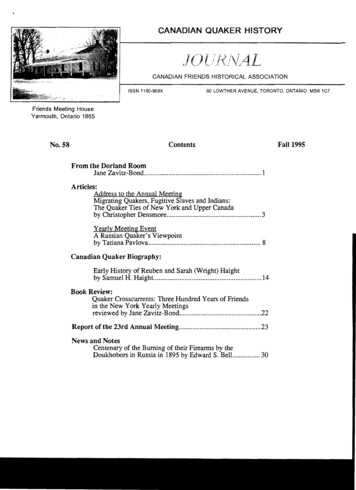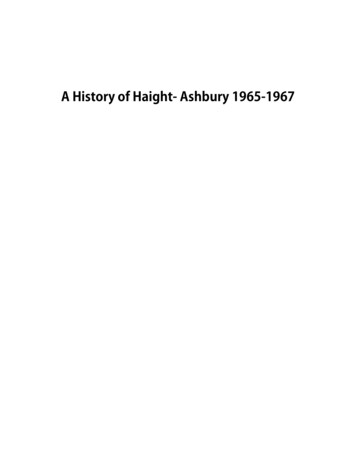
Transcription
A History of Haight- Ashbury 1965-1967
The Haight-AshburyA HistoryAuthor: Charles PerryPublisher: Random HouseDate: 1984ISBN: 0-394-41098-X
Table of ContentsPreface.11. Strange Clouds Gather .52. The First Flash.193. The Flash Goes On .354. Big Plans .575. The Be-In Era .776. The Deluge .1097. What Was That? .149Epilogue .171Illustrations .a
Preface"Have you ever been in a riot?" asks a former marijuana dealer named Roger. "You could bestanding there minding your own business and all of a sudden this thing, this feeling ormagnetic force from the crowd, just engulfs you and you actually start participating in theriot. There's an opposite end of the spectrum. If everybody goes around with the love andbrotherhood thing that they had in the Haight, when you walk into it you can be engulfed byit."That's why so many people walked into that thing and within two hours had their heads soturned around they took off their wingtips and put 'em down on the sidewalk and walked offinto some commune. That kind of thing happened hundreds of times a day. You got intothat feeling and it was just like the whole world was revolving around this thing that wasgrowing and you could see it grow."The Haight-Ashbury explosion of 1965-67 was perhaps the most written-about and leastunderstood event of the sixties. The reporters who descended on the neighborhood in thesummer of 1967 found it frightening or amusing, but in any case insane. They could notconceive how it happened because they didn't realize that it had a history—this thing thatwas growing and you could see it grow.Its history was what made it the apparent madhouse that it was. For some time the Haighthad been shaped by events that came from all sorts of surprising quarters, but wereobviously part of a single' event. These events seemed at the same time unexpected andinevitable—the essence of drama. Life in the Haight had the exaltation of a play.But people in the Haight weren't talking to reporters about history. Things had developed sofar beyond anybody's expectations that the only honorable course was to take every idea toan extreme—anything less was a cowardly evasion of destiny. So it was their ideas thatpeople in the Haight were telling reporters, ideas so wildly hopeful that they can scarcely berecalled without a pang of regret for lost hopes, mixed with a little embarrassment: "Theparadox of a culture reincarnated by itself: that the 'white-eye' who once annihilated thebuffalo must now, in action-reacted, be 'saved' from slaughtering himself by the Indianincarnate." "The unnatural state of the universe will not disappear until the last vestige ofhierarchy is destroyed." "Mafia is a state of mind—drop it."When I began researching this history in 1975, I was afraid that a lot of the people involvedin the Haight would be burnt out on the subject and reluctant to talk to a reporter about it,even a reporter like me who had been a Berkeley hippie with a number of friends in theHaight. A few years earlier they probably would have been, but now people were juststarting to reassess the period, and nearly everybody was eager to talk. Of the half-dozenpeople who refused to talk to me, four were still associated with the hard core of originalDiggers and refused on grounds that I would misrepresent them because I didn't share theirideology. There has been talk of an authorized Digger history. I hope they write it, and Ihope this book of mine provides them, and anyone else who writes about the HaightAshbury, with a reliable chronology.I am indebted to the following informants:1
Keith Abbott, Chester Anderson (com/co), Ray Anderson (Holy See Light Show), TonyKaufman Anderson (groupie), Willard Bain (author of Informed Sources), Paree Bakhtir(Love Burgers), Teddy Bear, Larry Blackburn, Bobby Bowles (Peg 'n Awl Leathers), StewartBrand (Prankster, Trips Festival), Ashleigh Brilliant (street poet), Lynn Brown (Mime Troupe,Digger), Joan Dierkes Carlisle, Luria Castel (Family Dog), Richard Cherney (House ofRichard), John Cipollina (Quicksilver Messenger Service), Allen Cohen (Oracle), VinceCresciman (Digger, I/Thou Coffee House), Faybeth Diamond, Bob Durso, Nancy Evans,Ernie Fosselius (Final Solution), David and Girl Freiberg (Quicksilver), Jerry Garcia (GratefulDead), Patrick Gleeson (Happening House), Lou Gottlieb (Morning Star Ranch), Bill Graham(Fillmore Auditorium), Linda Gravenites, Carglin Green (The Righteous Rag), Luther Greene(Straight Theater), Bill Ham (Pine Street, light-show artist), Ellen Harmon (Red Dog Saloon,Family Dog), Father Leon Harris (All Saints Church), Chet Helms (Family Dog), MendelHerscowitz (straight Haight Street merchant), Howard Hesseman (The Committee, KMPXdisc jockey), Gary Hirsh (Country Joe), Tom Hobson, Richard Hodge (lawyer), RichardHundgen, George Hunter (Charlatans), Roland Jacopetti (Open Theater, Morning Star), GaryJackson (Matrix), Jorma Kaukonen (Jefferson Airplane), Al Kelly (Red Dog, posters), KenKesey (Prankster), Harvey Kornspan (Digger), Mary Anne Kramer, Paul Krassner, Peter Krug(Wild Colors), Chandler Laughlin (Red Dog, KMPX), Seymour Locks (light-show inventor), SiLowinsky (Print Mint), Tom Mazzolini (music archivist), Michael McClure, Don McCoy(Rancho Olompali), Walter Medeiros (poster archivist), Barry Melton (Country Joe), MervynMillar, Larry Miller (KMPX), Victor and Gail Moscoso (posters), Moe Moskowitz, StanleyMouse (posters), Ron Nagel (Mystery Trend), Patt Nathe (Blue Unicorn), Richie Olsen(Charlatans), Steve Porterfield (Family Dog), Norwood Pratt (Love Conspiracy), Dean andLee Quarnstrom (Pranksters), Cindy Reade (Digger), Greg Reisner, Bill and Hillel Resner(Straight Theater), Roger the Dealer, Elias Romero (light show), Jon Sagen, Max Scherr{Barb), Rock Scully (Grateful Dead), Jerry Sealund (Far Fetched Foods), Ramon Sender(Tape Center, Trips Festival, Morning Star), Greg Shaw, Edmund Shea, Gretchen Sherman,Bob Simmons, Dr. David Smith (Free Clinic), Jeff Stallard, Rob Sutherland (All SaintsDigger), Nathan Terre, Ron Thelin (Psychedelic Shop), Bill Thompson (Jefferson Airplane),Hunter S. Thompson, Jack Towie (Family Dog), Teresa Tudury (All Night Apothecary), HallVan Vlack (Hearth Coffee Shop), Ben Van Meter (light show), Bill Wheeler (Wheeler'sRanch), Wes Wilson (posters), Leonard Wolfe (Happening House), Don Works (Red Dog).Needless to say, their opinions are not necessarily those expressed in this book, and I aloneam responsible for any errors. I am more particularly indebted to the following people, whogave me access to their files: Chester Anderson, Howard Hesseman, Tom Mazzolini, GaryJackson and Jann Wenner. Andersen's donation of a nearly complete file of com/co outputfrom January to July 1967 was invaluable.The books that proved useful to me were Ralph J. Gleason's The Jefferson Airplane and theSan Francisco Sound, which contains the first attempt to tell the early history of the Haight;Tom Wolfe's The Electric Kool-Aid Acid Test, about the Merry Pranksters; We Are the PeopleOur Parents Warned Us Against, Nicholas Von Hoff man's attempt to understand the sceneas of early summer 1967, two books of interviews, Voices from the Love Generation, byLeonard Wolfe, and Garcia, by Jann Wenner and Charles Reich; and Cooptation: The Storyof a Radio Station, an academic thesis by Susan Krieger on KMPX/KSAN. Scenes, asociology of the hippie and surfer movements by John Irwin, greatly helped me clarify mythinking about the dramaturgical elements of life in the Haight. The best contemporaryjournalism on the Haight was Jeff Jassen's weekly report in the Berkeley Barb, but therewas also useful coverage in the San Francisco Chronicle and the Oracle.2
Much light is cast on the mood and thinking of the time by Emmett Grogan's Ringolevio: ALife Played for Keeps and Marco Vassi's The Stoned Apocalypse, although the historicalvalue of both books is limited by their authors' grandiose self-images. Only a handful ofstraightforward novels have come from the psychedelic movement, the best being WillardBain's head-twisting Informed Sources, Billy Craddock's Be Not Content, which parodies theunspoken conclusion of Leary's "tune in, turn on, drop out" mantra—"freak out, fuck up,crawl back"; and the little-known Tripper, by Jocelyn (Exposition Press, 1972), whichexquisitely portrays the psychedelic life in all its anguish and aimless gorgeousness.3
1. Strange Clouds GatherWhy Was He Doing This? Wasn't It Bad Enough To Get Busted? Why Did Owsley Have ToAsk for trouble?On February 21,1965, California state narcotics agents had raided his home in Berkeley—asquat building nicknamed the Green Factory—and charged Augustus Owsley Stanley III withoperating a Methedrine laboratory. Now that the case had come to a hearing, every rule inthe book demanded he should get a haircut and a conservative suit and start looking like amisunderstood choirboy.But Owsley wasn't playing along. At one hearing, the short, dark ex-radar technicianshowed up in denim trousers and jacket; at the next he wore a sharp Italian suit. Hebroadcast dangerous, edgy resentment rather than decent fear. He managed to beat thecharges anyhow. His lawyer argued that although Owsley's home might have looked like aMethedrine lab—could scarcely be said to look like anything else, in fact—nevertheless nocompletely synthesized Methedrine had been found. So Owsley was free.At this point, according to the scenario held in common by narcs and drug people, a chemistwho was lucky enough to escape the law should disappear gratefully into the woodwork.However, the state of California still held the lab equipment it had confiscated during thebust, and Owsley wanted it back. It was his equipment, and he meant to use it. He sued thestate for it and got it back.Only then did Owsley disappear, slipping off for a few weeks to Los Angeles with hisgirlfriend, who until a few months before had been a graduate chemistry student at theUniversity of California. When they returned to Berkeley in April they had what he'd reallybeen wanting to make: LSD. Somewhat dubiously his Berkeley friends said they'd try thefunny-looking vitamin capsules that were slightly deformed from having been dosed withLSD out of an eyedropper.To their astonishment, it really was LSD. In fact it was very strong LSD. It was thestrongest LSD they'd ever had, devastatingly strong in an almost heavy-handed way thatrecalled Owsley's own insistent manner."Oh, hey," he told them in his mysterious, faintly irritable way, "those first ones were tooheavy. You only should have taken half." But even when he claimed he'd gotten the dosageworked out, this was still exceptional LSD. Under the name Bear Research Group, Owsleyhad already ordered the raw materials to make a million and a half doses.The United States was a busy place in early 1965. The civil rights movement was in fullheat. President Johnson was ordering the bombing of North Vietnam. "Student movement"radicalism was still news on college campuses. The pop art/camp movement had spawned anational fad for corny old Batman movies, and there was a whole new wave of rock and rollcoming from England, of all unexpected places, led by the wistful-irreverent Beatles andaccompanied by a raft of silly, energetic-looking Mod fashions. An ad campaign remindedeveryone that this was a fun-loving, uninhibited Pepsi Generation.But there was a strange feeling of desolation in the middle of all this activity. Maybe it wasthe persisting shock effect of President Kennedy's assassination or residual terror from thenuclear confrontation over Cuban missile emplacements. Whatever the reasons, itsometimes seemed that despite all the noise the party was over, and the world was settled,compartmentalized and devoid of high deeds and adventures.5
One thing that could cut away at the cut-and-dried feeling, if you were crazy enough tochance it, was taking certain drugs that altered mental processes—marijuana,amphetamines and psychedelics such as LSD. Here was territory that seemed pretty new.In fact, if you wanted a model for mind-drug use, there wasn't much to find. The BeatGeneration had experimented with a lot of drugs, but the Beats were now dispersed—at themoment their old San Francisco neighborhood of North Beach was a tourist trap full oftopless bars. Then there were the hipsters, who followed black ghetto fashions in drugs aswell as slang, clothing, jazz and so on. But like the Beats, the hipsters were in their thirtiesand forties now, and the ones a young person was likely to meet preferred alcohol andheroin to mind drugs.There was a new generation of bohemian-minded kids who were very interested in thesemind drugs. They were also interested in such traditional bohemian subjects as art,psychology, pacifism, exotic religions and anything else that stretched the limits ofunderstanding. They had no name for themselves comparable to the Beat Generation,though the Beats derisively called some of them hippies (junior grade hipsters), and bydefault that group had started using the name itself. The Beats looked down on hippies asimitation bohemians who were only interested in getting stoned and having a good timerather than doing something serious, like writing poetry or playing jazz. Another grievancewas that while the Beats were always down and out, the hippies seemed to have money.Most of them were selling a little marijuana.Closest kin to the hippies were the folkies, the bohemian fringe of the long-established folkmusic scene. They were the same age as the hippies and had the same sense of beingdisinherited by their elders-in-nonconformity, in their case the "protest song" radicals whosaw folk music as a political tool rather than a way of life. Of course hippies and folkies haddifferent tastes in music. The hippies went for the rock and roll of the British Invasiongroups and of Bob Dylan after he scandalized the folk purists by adopting the electric guitar.A lot of hippies, in fact, were folkies who had followed Dylan in his switch to rock.What was unique to the hippies was their attitude—an expansive, theatrical attitude ofbeing cool enough to have fun. They called themselves dudes and ladies rather than catsand chicks. Unlike Beats in their existential black and folkies in their homespun and denim,they wore flashy Mod clothes. Miniskirts, patterned stockings and "Beatle boots" would do,and Beatles-long hair was definitely becoming the mode for hippie men. Even better thanthe English fashions, though, were the Victorian and Edwardian clothes you could get fornext to nothing at thrift shops. They were finely made garments, and you could wear themwith a mustache and a swagger.Better still was to do all this and live in a Victorian house. San Francisco was full ofVictorians, since much of the city was rebuilt after the 1906 earthquake, and like Victorianclothes they were now unfashionable and cheap. The best neighborhood in the city for theEdwardian-Victorian motif was an area where many San Francisco State College studentslived, a rather forgotten part of the city called the Haight-Ashbury district, which wasconvenient by trolley to the State College campus and full of once-expensive houses. Youcould rent two floors of an old mansion for 175 a month, and get leather wallpaper andexpansive window seats and art nouveau stained glass and scrollwork. Some of the Statecrowd were carrying the motif to the limit, dressing like Edwardian toffs every day,furnishing their apartments entirely in period style, even unscrewing the light bulbs andhooking up the old gaslights.6
Hippies were scattered around in other places in the country, too, mostly near collegecampuses. The scene blossomed best where there was a high concentration of hippies. TakePine Street: three blocks of the San Francisco street of that name where there were fullyhalf a dozen apartment houses full of hippies and grass dealers. Pine Street was whatpeople called outrageous—people there simply ignored the possibility that neighbors or thepolice would find anything suspicious about their dress or behavior. Pine Streeters had it allfigured out. North of Pine was California Street, part of the wealthy Pacific Heights area;south of Pine was the black ghetto, the Fillmore District. Pine Streeters believed the policewere turning a blind eye to their blatant weirdness and open traffic in drugs because theywere keeping the foothills of Pacific Heights from becoming entirely black.In April and May, the new LSD with the brand name Owsley began making its way throughthe psychedelic communities around the San Francisco area. However many people thatmight be.That was one of the mysteries of psychedelics. Taking LSD was like being in a secretsociety. Hardly anything was being said about it publicly. As a matter of fact, LSD was notan illegal drug, but people acted as if it were; it seemed illegal. About the only place wherepsychedelics were openly discussed was in a tiny magazine called the Psychedelic Review,edited by ex-Harvard professor Timothy Leary and some associates. Leary's own writingsreinforced the secrecy of the whole thing, though, because he dwelt on the importance ofavoiding a panic situation, so people who followed him took their LSD in isolation, in theirhomes or out in the woods. There was no way of knowing how many people might bemessing with psychedelics. If you thought about it, you might conclude the only peopletaking LSD were Leary and the Harvard crowd, some Beats, and a few others, possibly notmany more than your own circle of insane friends.Around the same time that Owsley's name was becoming a household word in somehouseholds, there were rumors of a project that seemed designed to alleviate the adventureshortage. Some crazies were opening a totally Old West saloon with folk music in, of allplaces, the semi-ghost town of Virginia City, Nevada.Virginia City wasn't actually such an odd place for a hippie saloon. The old boomtown capitalof the Comstock Lode silver rush already had a colony of exotic people, including somepsychedelic users. The latter group was centered around a second-generation bohemiannamed Don Works, a member of the peyote-eating Native American Church who had movedout to the Comstock country to be with his coreligionists among the Washoe and PiuteIndians.Works lived on a little plot named the Zen Mine after a pair of nonproducing mine shaftsrunning into the dusty hillside behind his cinder-block cabin. The idea for the Red DogSaloon had been formed there a few months before, when Works, a tall desperado typenamed Chan Laughlin (who had once owned a Berkeley folk music coffeehouse), and a richfolkie named Mark Unobsky were stranded in Works' two-room cabin by a blizzard. Withnothing to do but get stoned and play the board game Risk, they started fantasizing about afolk nightclub to enliven the mountain evenings. It actually sounded plausible, becausethere was no decent nightlife around for competition, and particularly because folkmusicians were always passing through Nevada on their way between the Boston-New Yorkscene and San Francisco-Berkeley. Some fairly big names might be willing to stop off andplay a relaxed night or two.That was the original plan, anyway. Unobsky bought the old Comstock House building on CStreet, near the original claim of the wild silver rush that financed the Civil War and droveGermany off the silver standard. Bohemian carpenters were called in from Marin County,and Laughlin was dispatched to San Francisco for antique red velvet drapes and brassfittings.7
On one of these buying trips Laughlin stopped off at Pine Street, where he'd hidden out fora while a few months before when he figured the police were after him for smugglingmarijuana. While he was talking up the excitement of this stylish folk cabaret in the hills toa Pine Street friend, he met a fellow with a long blond Dutch boy haircut and a missing fronttooth who was dressed to the nines in Edwardian duds. It so happened that this Edwardiandude with the elusive, slightly formal manner had put together a musical group that mightfit right in.His was not a folk group, though, but a rock and roll band called the Charlatans. Well, whynot? The Beatles, Dylan, this band in Los Angeles named the Byrds that was being called afolk-rock group—suddenly it was clear that a hip rock and roll band was just what the RedDog needed. And the Charlatans already had a following. Bob Hunter, the Dutch boy blondwith the missing tooth, was a culture hero in certain circles at State College for his elegantEdwardiana. The pianist, Michael Ferguson, had the same sort of stature and had once runan unheard-of kind of store at the edge of the Haight-Ashbury. Magic Theater for MadmenOnly had sold nothing but antique clothes, knickknacks, a little art and a lot of marijuanastash jars.The only problem with the band was that Hunter, an artist and boy-wonder architect, hadconceived the Charlatans as a sort of pop art statement, an American response to theBritish rock groups. At the moment it was really only the concept of a rock band; they hadhundreds of publicity stills, featuring Edwardian clothes and twenties rowing-crew uniforms,but had never rehearsed. For months now they'd been growing their hair down to theirshoulders—much longer than the Beatles' hair—and carrying on like a rock band at parties,and now it was time to get down to finding out what they could play. A lot of work neededto be done. Hunter, for instance, couldn't play anything but tambourine and autoharp, andthere were those who said he couldn't play that.The Red Dog became a sort of Pine Street project. A collage artist and one-time motorcycleracer named Al Kelly went up to Virginia City to work on the remodeling. Ellen Harmon, therangy woman who shared his tiny room in Pine Street where the walls were painted withpop art sound effects ("Poww!" "Bawannnngggg!"), went as a waitress. There was anabstract expressionist painter on Pine Street who managed two of the apartment houses, ashaggy-bearded Southerner named Bill Ham. His light shows, which were like movingabstract paintings projected in brilliant colors on a screen, were Pine Street's favoriteevening entertainment. He designed a light box for the Red Dog that would pulsate withcolor in time with the music.Altogether, a couple of dozen people from San Francisco moved up to Virginia City for theRed Dog project. After a number of delays and false starts, the Red Dog Saloon finallyopened on June 29, 1965, advertised by a poster drawn by the Charlatans' pianist in a sortof old-timey medicine-show style that described the band as "The Limit of the Marvelous."The band moved up to Virginia City on opening day with one loudspeaker and a ten-wattamplifier.The sheriff came to see opening night. The new place was the only nightclub in town, andpeople had been pushing him to look into it anyway. All these city people dressing in vestsand string ties and celluloid collars—and that sign out front, too, with the slavering red dogon it.8
But he had to admit they'd done a hell of a job as he mounted the plank sidewalk, rebuiltand roofed over just as it had been in the 1860s. As he pushed in through the swingingdoors, he could see they'd spared no expense on the interior, either. All period furnishings,red and turquoise velvet drapes with a lot of gold braid, the whole place painted red withblack trim. The bartender was in a striped shirt with sleeve garters, and the waitresses wereall in saloon-maid bodices and net stockings. Some of the customers knocking back the beerand bourbon were in old-time getups as well.A couple of things, you couldn't figure whether they were out of place or not. Maybe in the1860s there could have been a 380-pound Washoe Indian bouncer in a top hat and aRainbow Girls sash. The musicians in those days surely didn't play rock and roll, but maybethey did get as looped as these guys on the stage seemed to be, rolling their eyes andstaggering and trying to play each other's instruments.But all told, it was enough to touch a man's heart. The least the sheriff could do was tohonor the hallowed Code of the West, which held that when a man entered a bar hechecked all his firearms at the door. "Check my gun?"Without blinking an eye, Don Works plucked the pistol out of the sheriff's hand, threw apracticed glance down the barrel, spun the chambers, cocked the hammer and fired off twoquick shots into the floor. "Works fine, sheriff," he said.Rock and roll meets the Old West—the possibilities were staggering. The Charlatans' gigstretched on far longer than the planned two weeks. People told their friends about it, andsome of the posters made it back to San Francisco, where they tended to be handed aroundfrom person to person rather than posted. More and more people made the three-hour drivejust to see whether it could be true, an Old West Bar with a hip rock band in the Edwardianstyle.As a matter of fact, the Charlatans had started changing their style. Stuck in Virginia Cityweek in and week out, they and everyone else working at the Red Dog fell into the Old Weststyle. In a way it was the only thing to do: get a pair of chaps and a ten-gallon hat andspend the afternoons picking off jackrabbits. Owsley's LSD had been around since openingnight, and on Mondays, when the Red Dog was dark, the staff would have LSD parties. Thesense of the frontier grew stronger and stronger.Some of the people envisioned the Red Dog as a movie. Chan Laughlin would lecture aboutit: "This is an Old Western town, and we're more Old Western than anybody else.Remember, when your feet hit the floor in the morning, you're in a Grade B movie. This isthat saloon down the street where the manager has his office under the stairs and all thegunhands sit around out front and periodically he comes out and motions a couple of themto ride away and rustle some cows. It's that place, complete with fancy girls going aroundbending over tables and the music and people roaring and ordering more drinks andcarrying on."Yes indeed. Everybody started wearing the clothes and carrying fancy firearms. Eachbartender as he came on shift brought his own personally selected bar pistol. After a whilethe Charlatans had a set of matched-caliber Winchester rifles they would carry onstage andlean up against the amplifier before picking up their guitars. Now, what was all this fussabout the Beatles and their so-called flashy style?Back in San Francisco, a far-out new kind of nightclub opened on July 4, but nobody wasgoing to it.9
Actually, there were people who went: people in the music business. The club, calledMother's, was opened by a Rabelaisian rock DJ who went by the name of "Big Daddy" TomDonahue. He ran the local rock music scene—managed bands, put on big shows at the CowPalace for teenagers and even had his own record label, Autumn Records, which specializedin teen rock bands like the Tikis and the Vejtables. Before he opened Mother's, the 400pound Big Daddy had held court over a crowd of promo men, agents and other DJs at asidewalk restaurant up the block, and that crowd naturally followed him to Mother's.The new place was nothing like a sidewalk café. Donahue had spent a fortune on it. He'dhired Beat woodworkers from Big Sur, and the walls were covered with undulatingsculptured wood and sheets of plastic paneling that pulsed with colored light in time withthe music. There were collages in the bathrooms and a big curtain instead of a front door.Pretty far out for a rock DJ who was pushing pimple cream all day. But who did he expect tocome besides his music biz friends? The entertainment was his own teen rock bands, butthe club's liquor license kept teenagers out.Then, on August 4, Donahue booked the New York folk-rock band the Lovin' Spoonful, andall of a sudden the place was packed with non-biz people, dressed in Mod Hash orEdwardiana—rock fans who were old enough to drink but preferred to dance. There weremore of them than they themselves had realized. The music biz people had never evenknown such people existed.When the Spoonful left after its four-week gig (which had coincided with their first hitrecord, "Do You Believe in Magic?"), this bright-feathered tribe of fans vanished, leavingMother's so empty it started featuring its own semi-nude dancer ("Topless Daughter Maria")like the other North Beach clubs.Everybody of college age had heard of Ken Kesey, at least as the novelist who wrote OneFlew Over the Cuckoo's Nest. There were rumors that he'd written the book partly on LSDand that he'd taken all sorts of psychedelics since 1959, when he'd been a 75-a-dayguinea pig at Veterans' Memorial Hospital in Menlo Park. He was known as a sort of experton psychedelics. He'd set a fashion for calling LSD acid (short for lysergic aciddiethylamide), to the horror of religious LSD eaters.In 1964 he had bought a 1939 International Harvester bus with the advance money fromhis second novel and he
A History of Haight- Ashbury 1965-1967 . The Haight-Ashbury A History Author: Charles Perry Publisher: Random House Date: 1984 ISBN: -394-41098-X . Table of Contents
